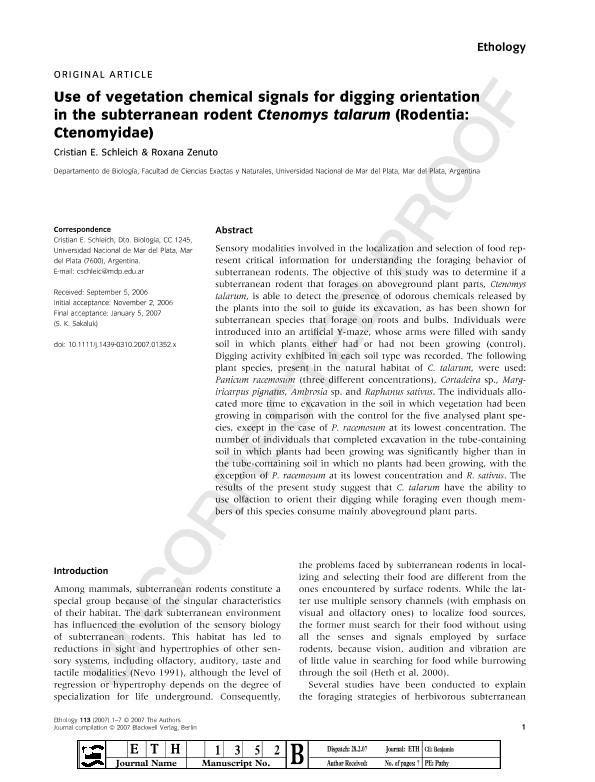Mostrar el registro sencillo del ítem
dc.contributor.author
Schleich, Cristian

dc.contributor.author
Zenuto, Roxana Rita

dc.date.available
2020-09-09T14:21:14Z
dc.date.issued
2007-06
dc.identifier.citation
Schleich, Cristian; Zenuto, Roxana Rita; Use of vegetation chemical signals for digging orientation in the subterranean rodent Ctenomys talarum (Rodentia: Ctenomyidae); Wiley Blackwell Publishing, Inc; Ethology; 113; 6; 6-2007; 573-578
dc.identifier.issn
0179-1613
dc.identifier.uri
http://hdl.handle.net/11336/113625
dc.description.abstract
Sensory modalities involved in the localization and selection of food represent critical information for understanding the foraging behavior of subterranean rodents. The objective of this study was to determine if a subterranean rodent that forages on aboveground plant parts, Ctenomys talarum, is able to detect the presence of odorous chemicals released by the plants into the soil to guide its excavation, as has been shown for subterranean species that forage on roots and bulbs. Individuals were introduced into an artificial Y‐maze, whose arms were filled with sandy soil in which plants either had or had not been growing (control). Digging activity exhibited in each soil type was recorded. The following plant species, present in the natural habitat of C. talarum, were used: Panicum racemosum (three different concentrations), Cortadeira sp., Margiricarpus pignatus, Ambrosia sp. and Raphanus sativus. The individuals allocated more time to excavation in the soil in which vegetation had been growing in comparison with the control for the five analysed plant species, except in the case of P. racemosum at its lowest concentration. The number of individuals that completed excavation in the tube‐containing soil in which plants had been growing was significantly higher than in the tube‐containing soil in which no plants had been growing, with the exception of P. racemosum at its lowest concentration and R. sativus. The results of the present study suggest that C. talarum have the ability to use olfaction to orient their digging while foraging even though members of this species consume mainly aboveground plant parts.
dc.format
application/pdf
dc.language.iso
eng
dc.publisher
Wiley Blackwell Publishing, Inc

dc.rights
info:eu-repo/semantics/openAccess
dc.rights.uri
https://creativecommons.org/licenses/by-nc-sa/2.5/ar/
dc.subject.classification
Otros Tópicos Biológicos

dc.subject.classification
Ciencias Biológicas

dc.subject.classification
CIENCIAS NATURALES Y EXACTAS

dc.title
Use of vegetation chemical signals for digging orientation in the subterranean rodent Ctenomys talarum (Rodentia: Ctenomyidae)
dc.type
info:eu-repo/semantics/article
dc.type
info:ar-repo/semantics/artículo
dc.type
info:eu-repo/semantics/publishedVersion
dc.date.updated
2020-08-18T19:08:32Z
dc.journal.volume
113
dc.journal.number
6
dc.journal.pagination
573-578
dc.journal.pais
Reino Unido

dc.journal.ciudad
Londres
dc.description.fil
Fil: Schleich, Cristian. Consejo Nacional de Investigaciones Científicas y Técnicas. Centro Científico Tecnológico Conicet - Mar del Plata. Instituto de Investigaciones Marinas y Costeras. Universidad Nacional de Mar del Plata. Facultad de Ciencias Exactas y Naturales. Instituto de Investigaciones Marinas y Costeras; Argentina
dc.description.fil
Fil: Zenuto, Roxana Rita. Consejo Nacional de Investigaciones Científicas y Técnicas. Centro Científico Tecnológico Conicet - Mar del Plata. Instituto de Investigaciones Marinas y Costeras. Universidad Nacional de Mar del Plata. Facultad de Ciencias Exactas y Naturales. Instituto de Investigaciones Marinas y Costeras; Argentina
dc.journal.title
Ethology

dc.relation.alternativeid
info:eu-repo/semantics/altIdentifier/doi/https://doi.org/10.1111/j.1439-0310.2007.01352.x
dc.relation.alternativeid
info:eu-repo/semantics/altIdentifier/url/https://onlinelibrary.wiley.com/doi/abs/10.1111/j.1439-0310.2007.01352.x
Archivos asociados
